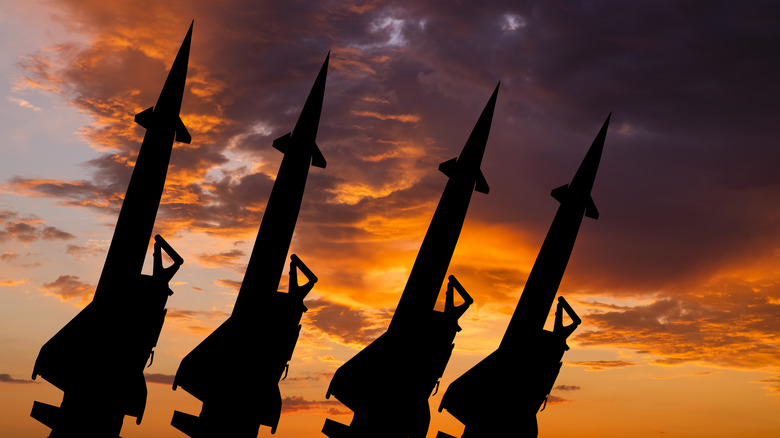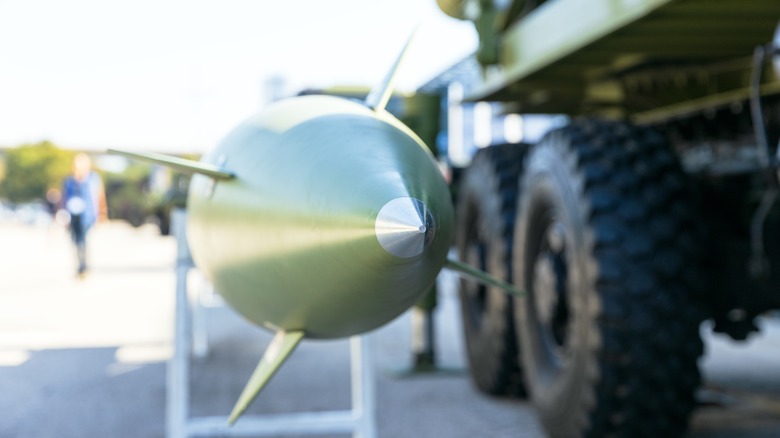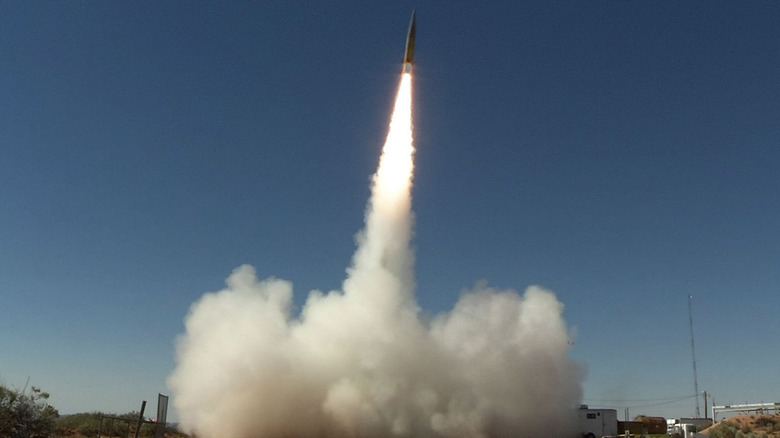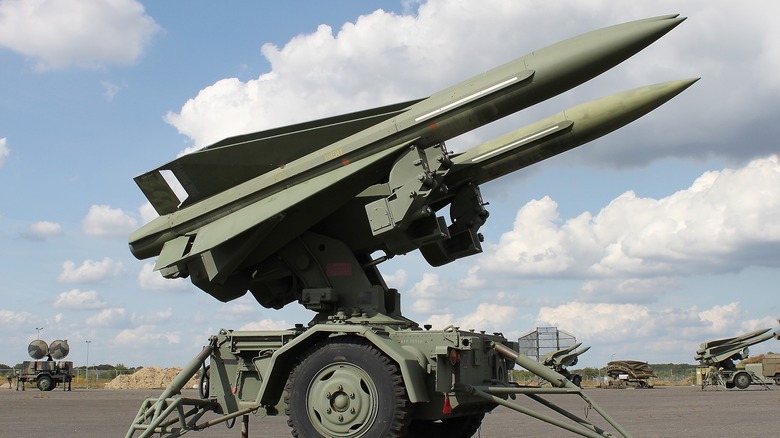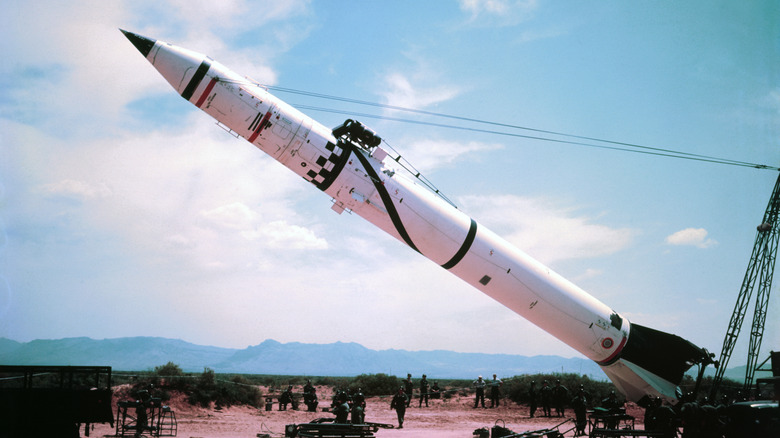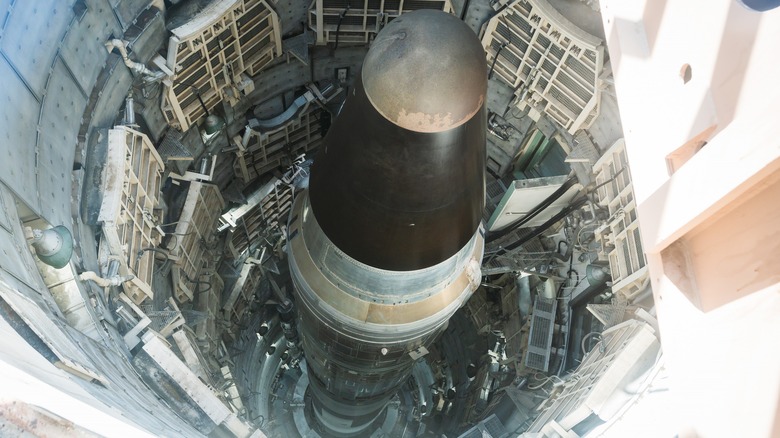Every Type Of Ballistic Missile Explained
Missiles are pretty straightforward, right? A metal tube gets shot into the sky, goes zoom, and then goes boom. Beyond this basic fact, things get complicated. The Center for Arms Control and Non-proliferation explains that ballistic missiles differ from cruise missiles because they act like cannonballs more than anything else. They get shot high up, fuel propels them to a peak point (an apogee), and then they more or less fall to their destination. Cruise missiles, on the other hand, stay low and shoot straighter, and require thrust the entire time to reach their target.
Ballistic missiles all have the same basic construction: propulsion systems, guidance systems, control systems, a warhead, and a frame to hold it all. They also follow the same three-part course on the way to their target: the boost phase (getting into the sky), midcourse (adjusting for the strike), and the terminal phase (the final minute before it strikes).
Beyond that, missile types differ by range. Tactical ballistic missiles (TBMs) have a range of less than 186 miles, short-range ballistic missiles (SRBMs) have a range between 186 miles and 620 miles, medium-range ballistic missiles (MRBMs) have a range between 620 and 1,860 miles, intermediate-range ballistic missiles (IRBMs) have a range between 1,860 and 3,410 miles, and intercontinental ballistic missiles (ICBMs) have a range further than 3,410 miles. There are also submarine-launched ballistic missiles (SLBMs) that shoot from water to land and anti-ship ballistic missiles (ASBMs) that strike targets out at sea. For simplicity's sake, this article will focus on the five land-based missile types.
Tactical ballistics missiles (TBMs)
Tactical ballistic missiles (TBMs) are the newest type of ballistic missile, first used in 1991 during Operation: Desert Storm. It might seem counterintuitive that the ballistic missile with the shortest range took the longest to develop, but as the U.S. Army says, the technology has roots in anti-missile technology developed by the U.S. during the Cold War to protect against incoming Soviet strikes. Ultimately, the U.S. Army says that TBMs are the most nimble type of ballistic missile designed as a "versatile weapon system capable of delivering precision strikes against a variety of targets."
The most prominent type of TBM used by the U.S. military is the ATACM (Army Tactical Missile System), which yes, is pronounced "attack 'em." Having a range of up to 186 miles and a price tag of $1.5 million per missile, ATACMs are the staple TBM used since Operation: Desert Storm. They still reach the atmosphere over a shorter distance and come down hard and fast, making them difficult to intercept. They have a swappable warhead designed to either hit a bunch of lightly armored units or single targets or structures. Built by Lockheed Martin, the company says that the newest ATACMs come with an updated GPS system and WDU18 warheads developed in 2017 in response to changing Department of Defense (DoD) requirements.
ATACMs are currently being phased out for an improved Lockheed Martin product, Precision Strike Missiles (PrSMs), which have a longer range but are still TBMs. They were tested for the first time very recently on November 20, 2024.
Short-range ballistic missiles (SRBMs)
Short-range ballistic missiles (SRBMs) were the first type of ballistic missile developed, and have the shortest range (less than 620 miles) of the four main types of ballistic missiles: short-range, medium-range, intermediate-range, and intercontinental. The missiles first cropped up in Germany in 1942 in the form of the V-2 rocket ("Vengeance Weapon Two"). As the Smithsonian National Air and Space Museum explains, these missiles were considered "long-range" at that point and had a maximum range of about 200 miles. While barely farther than modern-day tactical ballistic missiles (TBMs), that range was still far enough to penetrate neighboring nations from German borders.
Following the post-World War II arms race for better, faster, longer-ranged missiles, short-range ballistic missiles (by the modern definition of a range less than 620 miles) remain the most common type of missile fired in tests across the world. The Defense Intelligence Ballistic Missile Analysis Committee reports that in 2013 — the year with the most tests — SRBMs accounted for around 80% of all worldwide missile tests. We're not sure why this is the case, but that same report shows that more and more countries over the decades have developed ballistic missile capacity, including North Korea, Iran, Pakistan, and more.
SRBMs function like other ballistic missiles but require less fuel and are therefore smaller and lighter. There's a propulsion system that uses either liquid or solid fuel, guidance systems, control systems, a "postboost vehicle" with a separate fuel source for increased speed, accuracy, and versatility before a missile hits its target, and a warhead.
[Featured image by Army Photo via U.S. Department of Defense| Cropped and scaled]
Medium-range ballistic missiles (MRBMs)
Striking targets farther than a short-range ballistic missile (SRBM) but closer than an intermediate-range ballistic missiles (IRBM), medium-range ballistic missiles (MRBMs) cover targets farther than 620 miles but less than 1860 miles. To put that into perspective, that's about the distance from New York City to Albuquerque, New Mexico, or Barcelona to Moscow. According to the Defense Intelligence Ballistic Missile Analysis Committee, the Soviet Union was amongst the first nations to develop this range of missile in 1955, followed by China in 1964.
Mechanically and structurally, very little differentiates MRBMs from SRBMs IRBMs. The real difference lies in the tactical use of each weapon, which varies per missile system and country. Looking at China alone, the Defense Intelligence Ballistic Missile Analysis Committee says that the nation employs multiple MRBM types for various purposes. It uses the CSS-5 Mod 2 for nuclear deterrence within its specific geographical area, the Mod 4 also to protect important domestic locations, and the Mod 4 and Mod 5 for offensive attacks. Also, bear in mind that China is a big country. In the hands of a smaller nation, a missile with the range of an MRBM could have a very different set of functions.
But no matter the tactical purposes, MRBMs are just as threatening as any other ballistic missile. Recently in 2017, Lockheed Martin announced a successful deployment of its Aegis Combat System, which intercepted multiple incoming MRBMs during a test.
Intermediate-range ballistic missiles (IRBMs)
Now we get into the range of ballistic missiles that don't quite travel far enough to be classifiable as intercontinental ballistic missiles (ICBMs), but do travel far enough to hit other continents, anyway: intermediate-range ballistic missiles (IRBMs). As the United States Space Force says, the first IRBMs were developed alongside ICBMs during the 1950s to fill the tactical gap until ICBMs reached completion. In fact, the National Museum of the United States Air Force says that the first IRBM –the SM-75/PGM-17A Thor missile — was developed rather quickly because it was modeled on the design, engine, guidance system, warhead, etc., of the U.S.' ICBM Atlas missile.
Because IRBMs have a range of 1,860 to 3,410 miles (a few hundred miles shy of Miami, Florida to La Paz, Bolivia, for comparison), they could definitely strike other continents depending on the origin and target. This is why, for example, the United States and the Soviet Union signed a 1987 treaty that imposed a ban on this range of missile, referred to at the time by their nuclear warhead-delivering capabilities as INF (Intermediate-Range Nuclear Forces), per the U.S. Department of State.
But much like the other missiles discussed in this article, IRBMs can carry conventional explosives, as well. Russia recently employed a new "Oreshnik" IRBM against Ukrainian targets like the city of Dnipro in retaliation for Ukraine firing U.S.-made and -authorized ATACM TBMs against military targets in Russia.
Intercontinental ballistic missiles (ICBMs)
Finally, we come to the ballistic whopper that everyone has likely heard of: intercontinental ballistic missiles (ICBMs). ICBMs are exclusively designed for nuclear warheads and were the main focus of the ballistic missile Cold War arms race between the U.S. and Soviet Union mentioned earlier. Because they can travel farther than 3,410 miles, they're basically big guns pointed at the head of any country on Earth. The longest-ranged ICBM is Russia's R-36M (SS-18 Satan) missile, which can travel almost 10,000 miles. But despite the countries of the world currently owning over 12,100 nuclear-equipped ICBMs (and the U.S. owning 5,748 of them), thankfully not a single one has ever been launched outside of tests. They all exist for deterrence purposes.
Interesting Engineering tells us that early ICBMs weren't terribly accurate and couldn't pinpoint targets more specific than a city. The National Parks Service tells us that ICBMs went into development directly after the end of World War II in 1945, and reached fruition 12 years later in 1957 in the form of the Atlas missile. Needing a launch pad similar to a spacecraft, these missiles transitioned to the familiar, underground silo ICBMs — Minutemen — by the early 1960s. ICBMs are big because they require so much fuel to reach the altitude needed to reach their attack range. Missile Threat says that the North Korean Hwasong-15 reached almost an altitude of almost 3,000 miles in 2017. This means that it penetrated Earth's outermost atmospheric layer, the exosphere, nearly halfway to space.
